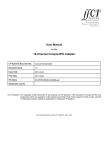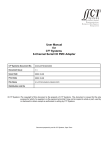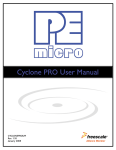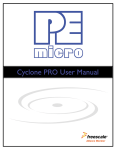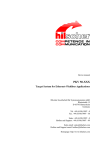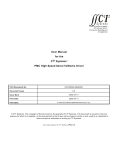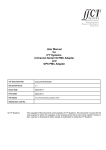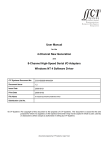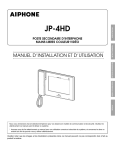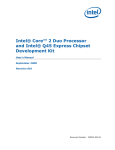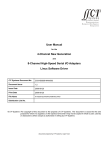Download User Manual for the GPS + 7-Channel Serial I/O and
Transcript
CCII Systems (Pty) Ltd Registration No. 1990/005058/07 C ommunications C omputer I ntellig ence I nteg ration User Manual for the GPS + 7-Channel Serial I/O Adapter and 8-Channel Serial I/O Adapter C²I² Systems Document No. CCII/LCP/6-MAN/007 Document Issue 1.1 Issue Date 2009-07-08 Print Date 2009-07-08 File Name W:\LCP\TECH\MAN\CLCMAN07.wpd Distribution List No. © C²I² Systems The copyright of this document is the property of C²I² Systems. The document is issued for the sole purpose for which it is supplied, on the express terms that it may not be copied in whole or part, used by or disclosed to others except as authorised in writing by C²I² Systems. Document prepared by and for C²I² Systems, Cape Town Amendment History Issue Description Date ECP No. 1.0 Baseline 2009-03-25 - 1.1 Improve document naming consistency 2009-07-08 CCII/LCP/6-ECP/017 CCII/LCP/6-MAN/007 CLCMAN07.wpd 2009-07-08 Issue 1.1 Page iii of vi Contents 1. Introduction and Scope . . . . . . . . . . . . . . . . . . . . . . . . . . . . . . . . . . . . . . . . . . . . . . . . . . . . . 1 1.1 1.2 2. Applicable and Reference Documents . . . . . . . . . . . . . . . . . . . . . . . . . . . . . . . . . . . . . . . . . 2 2.1 2.2 2.3 3. 3.2 3.3 3.4 3.5 3.6 3.7 3.8 3.9 3.10 3.11 3.12 3.13 3.14 3.15 System Overview . . . . . . . . . . . . . . . . . . . . . . . . . . . . . . . . . . . . . . . . . . . . . . . . . . . . . . . . . . . . . . . . . . . . . 3 3.1.1 GPS + 7-Channel Serial I/O Adapter . . . . . . . . . . . . . . . . . . . . . . . . . . . . . . . . . . . . . . . . . . . . . . . 3 3.1.2 8-Channel Serial I/O Adapter . . . . . . . . . . . . . . . . . . . . . . . . . . . . . . . . . . . . . . . . . . . . . . . . . . . . . 4 PMC Bus . . . . . . . . . . . . . . . . . . . . . . . . . . . . . . . . . . . . . . . . . . . . . . . . . . . . . . . . . . . . . . . . . . . . . . . . . . . 5 PCI 8-Channel UART . . . . . . . . . . . . . . . . . . . . . . . . . . . . . . . . . . . . . . . . . . . . . . . . . . . . . . . . . . . . . . . . . . 6 Configuration Space . . . . . . . . . . . . . . . . . . . . . . . . . . . . . . . . . . . . . . . . . . . . . . . . . . . . . . . . . . . . . . . . . . 7 PCI Interrupts . . . . . . . . . . . . . . . . . . . . . . . . . . . . . . . . . . . . . . . . . . . . . . . . . . . . . . . . . . . . . . . . . . . . . . . . 7 Configuration EEPROM . . . . . . . . . . . . . . . . . . . . . . . . . . . . . . . . . . . . . . . . . . . . . . . . . . . . . . . . . . . . . . . . 7 Complex Programmable Logic Device (CPLD) . . . . . . . . . . . . . . . . . . . . . . . . . . . . . . . . . . . . . . . . . . . . . . 8 GPS module . . . . . . . . . . . . . . . . . . . . . . . . . . . . . . . . . . . . . . . . . . . . . . . . . . . . . . . . . . . . . . . . . . . . . . . . . 8 GPS Antenna Connector . . . . . . . . . . . . . . . . . . . . . . . . . . . . . . . . . . . . . . . . . . . . . . . . . . . . . . . . . . . . . . . 8 RS-232 Transceivers . . . . . . . . . . . . . . . . . . . . . . . . . . . . . . . . . . . . . . . . . . . . . . . . . . . . . . . . . . . . . . . . . . 8 RS-485 Transceivers . . . . . . . . . . . . . . . . . . . . . . . . . . . . . . . . . . . . . . . . . . . . . . . . . . . . . . . . . . . . . . . . . . 9 Serial Channel Configuration DIP Switch S6 . . . . . . . . . . . . . . . . . . . . . . . . . . . . . . . . . . . . . . . . . . . . . . . . 9 3.12.1 GPS + 7-Channel Serial I/O Adapter . . . . . . . . . . . . . . . . . . . . . . . . . . . . . . . . . . . . . . . . . . . . . . . 9 3.12.2 8-Channel Serial I/O Adapter . . . . . . . . . . . . . . . . . . . . . . . . . . . . . . . . . . . . . . . . . . . . . . . . . . . . 10 Signal Ground Configuration DIP Switch S5 . . . . . . . . . . . . . . . . . . . . . . . . . . . . . . . . . . . . . . . . . . . . . . . 11 RS-485 Termination DIP Switches S1 to S4 . . . . . . . . . . . . . . . . . . . . . . . . . . . . . . . . . . . . . . . . . . . . . . . 12 PMC Connectors . . . . . . . . . . . . . . . . . . . . . . . . . . . . . . . . . . . . . . . . . . . . . . . . . . . . . . . . . . . . . . . . . . . . 13 3.15.1 PMC Pn4 Rear I/O Pin Assignments . . . . . . . . . . . . . . . . . . . . . . . . . . . . . . . . . . . . . . . . . . . . . . 13 Serial Interfaces . . . . . . . . . . . . . . . . . . . . . . . . . . . . . . . . . . . . . . . . . . . . . . . . . . . . . . . . . . 15 4.1 4.2 4.3 5. Applicable Documents . . . . . . . . . . . . . . . . . . . . . . . . . . . . . . . . . . . . . . . . . . . . . . . . . . . . . . . . . . . . . . . . . 2 Reference Documents . . . . . . . . . . . . . . . . . . . . . . . . . . . . . . . . . . . . . . . . . . . . . . . . . . . . . . . . . . . . . . . . . 2 Specifications . . . . . . . . . . . . . . . . . . . . . . . . . . . . . . . . . . . . . . . . . . . . . . . . . . . . . . . . . . . . . . . . . . . . . . . . 2 Architecture . . . . . . . . . . . . . . . . . . . . . . . . . . . . . . . . . . . . . . . . . . . . . . . . . . . . . . . . . . . . . . 3 3.1 4. Scope . . . . . . . . . . . . . . . . . . . . . . . . . . . . . . . . . . . . . . . . . . . . . . . . . . . . . . . . . . . . . . . . . . . . . . . . . . . . . . 1 Introduction . . . . . . . . . . . . . . . . . . . . . . . . . . . . . . . . . . . . . . . . . . . . . . . . . . . . . . . . . . . . . . . . . . . . . . . . . 1 Overview . . . . . . . . . . . . . . . . . . . . . . . . . . . . . . . . . . . . . . . . . . . . . . . . . . . . . . . . . . . . . . . . . . . . . . . . . . 15 Line Driver Selection . . . . . . . . . . . . . . . . . . . . . . . . . . . . . . . . . . . . . . . . . . . . . . . . . . . . . . . . . . . . . . . . . 15 Universal Asynchronous Receiver Transmitter (UART) . . . . . . . . . . . . . . . . . . . . . . . . . . . . . . . . . . . . . . . 15 GPS Interface . . . . . . . . . . . . . . . . . . . . . . . . . . . . . . . . . . . . . . . . . . . . . . . . . . . . . . . . . . . . 16 5.1 5.2 5.3 5.4 5.5 5.6 5.7 5.8 Overview of the GPS Interface . . . . . . . . . . . . . . . . . . . . . . . . . . . . . . . . . . . . . . . . . . . . . . . . . . . . . . . . . 16 GPS Module Specifications . . . . . . . . . . . . . . . . . . . . . . . . . . . . . . . . . . . . . . . . . . . . . . . . . . . . . . . . . . . . 16 Architecture of GPS module . . . . . . . . . . . . . . . . . . . . . . . . . . . . . . . . . . . . . . . . . . . . . . . . . . . . . . . . . . . 16 Default Configuration . . . . . . . . . . . . . . . . . . . . . . . . . . . . . . . . . . . . . . . . . . . . . . . . . . . . . . . . . . . . . . . . . 17 Configuration . . . . . . . . . . . . . . . . . . . . . . . . . . . . . . . . . . . . . . . . . . . . . . . . . . . . . . . . . . . . . . . . . . . . . . . 17 External Backup Battery . . . . . . . . . . . . . . . . . . . . . . . . . . . . . . . . . . . . . . . . . . . . . . . . . . . . . . . . . . . . . . 17 Pulse Per Second Signal . . . . . . . . . . . . . . . . . . . . . . . . . . . . . . . . . . . . . . . . . . . . . . . . . . . . . . . . . . . . . . 17 GPS Module . . . . . . . . . . . . . . . . . . . . . . . . . . . . . . . . . . . . . . . . . . . . . . . . . . . . . . . . . . . . . . . . . . . . . . . . 17 Annexure A . . . . . . . . . . . . . . . . . . . . . . . . . . . . . . . . . . . . . . . . . . . . . . . . . . . . . . . . . . . . . . . . 18 SAMTEC MMCX to SMA Cable Assembly . . . . . . . . . . . . . . . . . . . . . . . . . . . . . . . . . . . . . . . . . . . . . . . . . . . . . . 18 Annexure B . . . . . . . . . . . . . . . . . . . . . . . . . . . . . . . . . . . . . . . . . . . . . . . . . . . . . . . . . . . . . . . . 19 Installation Instructions . . . . . . . . . . . . . . . . . . . . . . . . . . . . . . . . . . . . . . . . . . . . . . . . . . . . . . . . . . . . . . . . . . . . . . 19 CCII/LCP/6-MAN/007 CLCMAN07.wpd 2009-07-08 Issue 1.1 Page iv of vi List of Tables Table 1 : PCI Configuration Space . . . . . . . . . . . . . . . . . . . . . . . . . . . . . . . . . . . . . . . . . . . . . . . . . . . . . . . . . . . . . . . . . . 7 Table 2 : S6 Codes for the GPS + 7-Channel Serial I/O Adapter . . . . . . . . . . . . . . . . . . . . . . . . . . . . . . . . . . . . . . . . . . 10 Table 3 : S6 Codes for the 8-Channel Serial I/O Adapter . . . . . . . . . . . . . . . . . . . . . . . . . . . . . . . . . . . . . . . . . . . . . . . 11 Table 4 : Switch S5 RS-232 Ground Connections . . . . . . . . . . . . . . . . . . . . . . . . . . . . . . . . . . . . . . . . . . . . . . . . . . . . . 12 Table 5 : S1 to S4 RS-485 Termination Resistor Selection . . . . . . . . . . . . . . . . . . . . . . . . . . . . . . . . . . . . . . . . . . . . . . 12 Table 6 : Pn4 Pin Assignments for the 8-Channel Serial I/O Adapter . . . . . . . . . . . . . . . . . . . . . . . . . . . . . . . . . . . . . . 13 Table 7 : Pn4 Pin Assignments for the GPS + 7-Channel Serial I/O Adapter . . . . . . . . . . . . . . . . . . . . . . . . . . . . . . . . 14 Table 8 : GPS Module Specifications . . . . . . . . . . . . . . . . . . . . . . . . . . . . . . . . . . . . . . . . . . . . . . . . . . . . . . . . . . . . . . . 16 List of Figures Figure 1 : Functional Block Diagram of the GPS + 7-Channel Serial I/O Adapter . . . . . . . . . . . . . . . . . . . . . . . . . . . . . . 3 Figure 2 : Functional Block Diagram of the 8-Channel Serial I/O Adapter . . . . . . . . . . . . . . . . . . . . . . . . . . . . . . . . . . . . 4 Figure 3 : 8-Channel Serial I/O Adapter . . . . . . . . . . . . . . . . . . . . . . . . . . . . . . . . . . . . . . . . . . . . . . . . . . . . . . . . . . . . . . 5 Figure 4 : GPS + 7-Channel Serial I/O Adapter . . . . . . . . . . . . . . . . . . . . . . . . . . . . . . . . . . . . . . . . . . . . . . . . . . . . . . . . 5 Figure 5 : GPS Receiver Block Diagram . . . . . . . . . . . . . . . . . . . . . . . . . . . . . . . . . . . . . . . . . . . . . . . . . . . . . . . . . . . . 16 Figure 6 : SAMTEC Custom Cable Assembly . . . . . . . . . . . . . . . . . . . . . . . . . . . . . . . . . . . . . . . . . . . . . . . . . . . . . . . . 18 Figure 7 : 8-Channel Serial I/O Adapter on PMC Host Carrier Card . . . . . . . . . . . . . . . . . . . . . . . . . . . . . . . . . . . . . . . 19 Figure 8 : GPS + 7-Channel Serial I/O Adapter on PMC Host Carrier Card . . . . . . . . . . . . . . . . . . . . . . . . . . . . . . . . . 19 CCII/LCP/6-MAN/007 CLCMAN07.wpd 2009-07-08 Issue 1.1 Page v of vi Abbreviations and Acronyms BIST CC CCPMC CD CEP CPLD CS CTS DGPS DIP DSR DTR EEPROM GPS HCC I/O INT IRQ LSB MHz MSB NMEA PCB PCI PMC PPS RI RS-232 RS-485 RTCM RTS Rx SA Tx UART VHDL VHSIC Built-In Self Test Conduction-Cooled Conduction-Cooled PMC Carrier Detect Circular Error Probability Complex Programmable Logic Device Chip Select Clear to Send Differential GPS Dual In-line Package Data Set Ready Data Terminal Ready Electrically Erasable and Programmable Read Only Memory Global Positioning System Host Carrier Card Input / Output Interrupt Interrupt Request Least Significant Bit MegaHertz Most Significant Bit National Marine Electronics Association Printed Circuit Board Peripheral Component Interconnect PCI Mezzanine Card Pulse Per Second Ring Indicator (Electronics Industries Association) Recommended Standard 232, or : EIA-232 (Electronics Industries Association) Recommended Standard 485, or : EIA-485 Radio Technical Commission for Maritime Services Request To Send Receive Selective Availability Transmit Universal Asynchronous Receiver Transmitter VHSIC Hardware Description Language Very High Speed Integrated Circuit CCII/LCP/6-MAN/007 CLCMAN07.wpd 2009-07-08 Issue 1.1 Page vi of vi 1. Introduction and Scope 1.1 Scope This document serves as a user manual for the GPS + 7-Channel Serial I/O Adapter and 8-Channel Serial I/O Adapter. 1.2 Introduction This Serial I/O Adapter incorporates a PCI to 8-Channel Serial UART Device and is available in either one of two configurations : • • Seven serial I/O channels with an integrated GPS module Eight serial I/O channels (without GPS module) Each serial channel’s external interface is user configurable in either RS-232 or RS-485 modes of operation. Onboard programmable logic controls the adapter’s external serial interfaces. Serial channel configuration (RS-232 or RS-485 electrical modes, RS-485 Multidrop mode and RS-485 Flow Control mode) is set by entering a binary code on a configuration DIP switch. Each serial channel has bus termination resistors which can be selectively switched in for proper RS-485 line termination. This is done by asserting the appropriate DIP Switches for individual RS-485 differential signal pairs. CCII/LCP/6-MAN/007 CLCMAN07.wpd 2009-07-08 Issue 1.1 Page 1 of 19 2. Applicable and Reference Documents 2.1 Applicable Documents 2.1.1 EXAR Corporation Datasheet, EXAR XR17D158 Universal (3.3V and 5V) PCI Bus Octal UART, Revision 1.2.2, dated August 2005. 2.1.2 MAXIM Semiconductors Datasheet, MAX3080E-MAX3089E ±15kVESD-Protected, Fail-Safe, High-Speed (10Mbps), Slew-Rate-Limited RS-485/RS-422 Transceivers, Revision 1, dated May 2006. 2.1.3 Texas Instruments Datasheet, SN65C3243, SN75C3243 3-V to 5.5-V Multichannel RS-232 Compatible Line Driver/Receiver, Revision SLLS353G, dated November 2004. 2.1.4 u-blox AG, LEA-4A, LEA-4H, LEA-4M, LEA-4P, LEA-4R, LEA-4S, LEA-4T Antaris®4 GPS Modules Data Sheet, Revision 1, dated 2007-05-25. 2.2 Reference Documents None. 2.3 Specifications 2.3.1 PCI Special Interest Group, PCI Local Bus Specification, Rev. 2.3, dated 2002-03-29. 2.3.2 IEEE Standard Physical and Environmental Layers for PCI Mezzanine Cards (PMC) : PMC, P1386.1-2001, dated 2001-06-14. 2.3.3 IEEE Standard for a Common Mezzanine Card (CMC) Family : CMC, P1386-2001, dated 2001-06-14. 2.3.4 ANSI/VITA 20-2001 American National Standard for Conduction Cooled PMC, approved 2001-08-31. CCII/LCP/6-MAN/007 CLCMAN07.wpd 2009-07-08 Issue 1.1 Page 2 of 19 3. Architecture 3.1 System Overview The serial I/O interface of the Serial I/O Adapter is routed externally via the 64-pin PMC rear I/O connector, Pn4. Having eight serial channels, this gives an I/O allocation of eight I/O lines per serial channel. 3.1.1 GPS + 7-Channel Serial I/O Adapter On the GPS + 7-Channel Serial I/O Adapter, Channel H of the PCI-UART is dedicated to communication with the onboard GPS module. The GPS unit supports the reception of Differential GPS (DGPS) correction data via the Channel H external serial I/O interface. This external interface is configurable in either RS-232 or RS-485 modes of operation and is controlled by the Channel H mode setting. The GPS unit has a dedicated, programmable Pulse Per Second (PPS) output, available offboard to the user via the Channel H external interface as either an RS-232 or RS-485 signal. This PPS signal is connected to a hardware counter on the PCI-UART device as well, which could in turn be configured to generate an interrupt after a user-specified amount of PPS ticks. A permanent external signal ground connection is made via Pin 47 on Pn4, which is the ground reference for offboard RS-232 signalling, as well as being the common ground connection used by the optional external GPS backup battery (refer to Table 7). The onboard GPS module connects to an external active GPS antenna via a supplied “pigtail” cable assembly. Two slots in the adapter’s PCB provide maximum flexibility for routing the antenna cable offboard. An optional external backup battery can be connected to the GPS unit (via the Pn4 rear I/O connector), which would aid the GPS module in achieving faster GPS fixes after a system restart. Block diagram of the GPS + 7-Channel Serial I/O adapter is shown in Figure 1. PMC Bus 14,7456 MHz Clock Serial Mode DIP Switch S6 Termination Resistors Termination DIP Switches S1 to S4 Enable Lines PCI PCI 8-Channel UART Channels A to G Ch. H GPS Module PPS Bus Mode Decoding Logic DGPS+PPS RS-232 Transceivers (Ch. A to G) RS-485 Transceivers (DGPS+PPS) RS-232 Transceiver (DGPS+PPS) EEPROM (optional) Rear I/O Connector RS-485 Transceivers (Ch. A to G) CPLD GPS backup battery GPS Antenna Connector Figure 1 : Functional Block Diagram of the GPS + 7-Channel Serial I/O Adapter CCII/LCP/6-MAN/007 CLCMAN07.wpd 2009-07-08 Issue 1.1 Page 3 of 19 3.1.2 8-Channel Serial I/O Adapter On the 8-Channel Serial I/O Adapter, Channels A to G each provide the eight standard modem signals (Tx, Rx, CTS, RTS, DSR, DTR, RI and CD) in RS-232 mode. Channel H has a reduced number of signals in RS-232 mode (only Tx, Rx, CTS and RTS), due to the external signal ground connection (shared by all RS-232 channels) taking up four pins on the Channel H external I/O interface. The RS-232 signal ground lines are manually connected / disconnected using DIP Switch S5. This is different from the configuration found on the GPS + 7-Channel Serial I/O Adapter, where a single permanent external ground connection is made via Pin 47 on connector Pn4. Care should be taken not to engage the S5 signal ground connections if Channel H is configured in RS-485 mode, for the reason that these signal ground connections and the Channel H RS-485 signals share the same Pn4 rear I/O pins (refer to Table 6). In RS-485 mode, Tx, Rx, CTS and RTS signals are available on all of Channels A through H. If at least one channel is configured in RS-232 mode, an external signal ground connection is required and will have to be made via DIP Switch S5. Due to the fact that these signal ground lines are multiplexed with the Channel H RS-485 signal I/O lines, RS-485 signalling will thus no longer be possible on Channel H once these signal ground connections have been made. This implies that Channel H can only be configured in RS-485 mode if none of Channels A to G are configured in RS-232 mode either and thus no external signal ground connection is required. Conversely, should any one of Channels A to G be configured in RS-232 mode, then Channel H should also be configured in RS-232 mode and the external signal ground connections should be made available via the rear I/O connector. It follows that, when assigning RS-232 Channels, Channel H should be the first Channel to elect for that role. Block diagram of the 8-Channel Serial I/O Adapter is shown in Figure 2. PMC Bus 14,7456 MHz Clock Serial Mode DIP Switch S6 Termination Resistors Termination DIP Switches S1 to S4 Enable Lines PCI PCI 8-Channel UART Channels A to H RS-485 Transceivers (Ch. A to G) RS-232 Transceivers (Ch. A to G) RS-485 Transceivers (Ch. H) Bus Mode Decoding Logic RS-232 Transceiver (Ch. H) Rear I/O Connector CPLD EEPROM (optional) RS-232 Ground DIP Switch S5 Figure 2 : Functional Block Diagram of the 8-Channel Serial I/O Adapter CCII/LCP/6-MAN/007 CLCMAN07.wpd 2009-07-08 Issue 1.1 Page 4 of 19 Depicted below are photographs of both adapter configurations : Figure 3 : 8-Channel Serial I/O Adapter Figure 4 : GPS + 7-Channel Serial I/O Adapter Typical installation photos are shown in Annexure B. 3.2 PMC Bus The Serial I/O Adapter can be installed on any Host Carrier Card (HCC) conforming to the PMC specification and which supports Universal PCI signalling (either 3,3 V or 5,0 V). The PMC interface consists of a 32-bit PCI bus interface and a number of bus-mode signals. Bus-mode signalling is implemented using dedicated logic ICs. Bus-mode signalling prevents the Serial I/O Adapter from CCII/LCP/6-MAN/007 CLCMAN07.wpd 2009-07-08 Issue 1.1 Page 5 of 19 operating when plugged into a non-PMC slot and also allows the host to sense the presence of a Serial I/O Adapter in a PMC slot. The Serial I/O Adapter supports only 32-bit PCI communications. The PCI interface is implemented using a PCI based eight-channel UART and supports PCI bus speeds of 33 MHz. 3.3 PCI 8-Channel UART This device is an octal PCI bus Universal Asynchronous Receiver and Transmitter (UART) with support for universal PCI bus I/O voltage levels, making it suitable for use in a wide range of 3,3 V and 5,0 V PCI hosts. A global interrupt source register provides complete interrupt status indication for all 8 channels to speed up interrupt parsing. Each UART has its own 16C550-compatible configuration register set and features the following : • • • • • • • transmit and receive FIFOs of 64 bytes each fully programmable transmit and receive FIFO trigger levels transmit and receive FIFO level counters automatic RTS/CTS or DTR/DSR hardware flow control with programmable hysteresis levels automatic software (Xon/Xoff) flow control a 16-bit general purpose timer/counter support for RS-485 multidrop mode For a detailed description of the PCI UART register interface and its operation, please refer to the XR17D158 UART Datasheet [2.1.1]. CCII/LCP/6-MAN/007 CLCMAN07.wpd 2009-07-08 Issue 1.1 Page 6 of 19 3.4 Configuration Space The PCI interface defines a standard programming model for the configuration of PCI devices. This interface is defined as the Configuration Space. Table 1 below shows the Configuration Space as defined by the PCI bus specification : AD31-23 AD22-16 AD15-8 AD7-0 Address Device ID(0x0158) Vendor ID(0x13AB) 0x00 Status Command 0x04 Class Code(0x070002) BIST Header Type Latency Timer 0x08 Cache Size(0x00) 0x0C Memory Base Address Register (BAR) 0x10 Unimplemented Base Address Register 0x14 Unimplemented Base Address Register 0x18 Unimplemented Base Address Register 0x1C Unimplemented Base Address Register 0x20 Unimplemented Base Address Register 0x24 Reserved 0x28 Subsystem ID Max Latency(0x00) Revision ID(0x01) Subsystem Vendor ID 0x2C Reserved 0x30 Reserved 0x34 Reserved 0x38 Min Grant(0x00) Interrupt Pin(0x01) Interrupt Line 0x3C Table 1 : PCI Configuration Space The location of the configuration registers is defined by the HCC at startup. 3.5 PCI Interrupts The PMC Adapter supports interrupts on the INTA# pin only. This is reflected in the Interrupt Pin Register of the Configuration Space, as defined in Table 1. 3.6 Configuration EEPROM The PCI UART supports an optional EEPROM device to store the vendor and sub-vendor ID and adapter model numbers. This information is only used during plug-and-play auto configuration of the PCI local bus, where this data would facilitate automatic hardware installation onto the PCI bus. The EEPROM interface consists of four signals, EEDI, EEDO, EECS, and EECK. The EEPROM is, however, not needed when auto configuration is not required in the end application and is thus omitted from the default build. However, should the user application require non-volatile memory for other purposes it is possible to store and retrieve data stored on the EEPROM through a special PCI device configuration register. For such applications the adapter can be specially ordered with the EEPROM installed. Contact Support for further information. CCII/LCP/6-MAN/007 CLCMAN07.wpd 2009-07-08 Issue 1.1 Page 7 of 19 3.7 Complex Programmable Logic Device (CPLD) The electrical configuration of the adapter’s I/O interface is controlled by programmable logic implemented in a CPLD. Tables 2 and 3 (refer to Paragraph 3.12) lists all available modes of operation for both versions of the adapter. Each listed mode of operation has an associated binary code which can be entered into configuration DIP Switch S6 to specify the adapter’s serial I/O configuration or “mode”. Each serial channel is user configurable in either RS-232 or RS-485 modes of operation. The PCI-UART device also supports RS-485 multidrop mode with user specifiable transmit / receive turn-around delays. Multidrop mode is available on all RS-485 channels. The Channel A to D RS-485 Channels can be extended to include the DSR and DTR flow control signals (in addition to the standard CTS and RTS signals). Channel A can be extended even further in RS-485 mode, to additionally make available the CD and RI signals as well. Extending Channels A to D as described above however comes at the cost of sacrificing other serial I/O channels, due to the limited overall number of rear I/O pins available on Pn4. The CPLD control logic can be customised, should that be required for the application. Please contact Support for further information. 3.8 GPS module The GPS module on the GPS + 7-Channel Serial I/O Adapter is the u-blox LEA-4S Integrated GPS module. It features a 4 Hz position update rate with a -157 dBm receiver sensitivity. It also supports the reception of Differential GPS (DGPS) correction data. An external backup battery can be connected for faster GPS lock-on during system restart (so called “warm” start). Dedicated active antenna short circuit protection and open circuit detection circuitry is integrated onto the Serial I/O Adapter. A Pulse Per Second (PPS) output from the GPS module is available offboard as either an RS-232 or RS-485 signal, as well as being connected to a hardware counter on the PCI UART device itself. An overview of the GPS unit’s operation and interface is given in Paragraph 5. For detailed information please refer to the LEA-4S Datasheet [2.1.4]. 3.9 GPS Antenna Connector A straight female MMCX antenna connector is installed on the component side of the Serial I/O Adapter. A mating right-angle male MMCX connector can swivel towards either one of two slots in the adapter’s PCB, providing two distinct routing options for taking the antenna cable offboard. A single 300 mm length male MMCX to female SMA “pigtail” cable is provided with the adapter (refer to Annexure A). It is suggested that only original Samtec mating MMCX connectors be used to ensure a secure fit and conformance to the I/O area height restriction of the ANSI/VITA 20-2001 standard [2.3.4]. For appropriate GPS active antenna selection, please refer to the u-blox AG, LEA-4S Datasheet [2.1.4]. 3.10 RS-232 Transceivers The eight onboard RS-232 transceivers are individually enabled / disabled under control of the CPLD. Each can transmit / receive serial data at rates of up to 1 Mbit/s (which is the maximum data rate supported by the RS-232 transceivers) over distances of up to ten metres. The PCI UART device can however be configured to communicate at much faster data rates (up to 6,25 Mbit/s per channel). Care should thus be taken to ensure that user software limits RS-232 data rates to a maximum of 1 Mbit/s. CCII/LCP/6-MAN/007 CLCMAN07.wpd 2009-07-08 Issue 1.1 Page 8 of 19 3.11 RS-485 Transceivers The sixteen onboard RS-485 transceivers (two per serial channel) are also individually controlled by the CPLD control logic. Each can transmit / receive serial data up to the maximum UART data rate of 6,25 Mbit/s over distances of up to one hundred metres. Transmission distances of up to one kilometre are possible at lower data rates. 3.12 Serial Channel Configuration DIP Switch S6 DIP Switch S6 is used as input to the CPLD to specify the serial channel configuration. Tables 2 and 3 list all the available modes of operation for both versions of the adapter, specifying the binary code for each configuration. Switch S6 uses Active Low signalling, thus a “0" in Tables 2 and 3 equates to the ON position and a “1" equates to the OFF position. A binary code of “10000001" is thus keyed into Switch S6 as : OFF-ON-ON-ON-ON-ON-ON-OFF. 3.12.1 GPS + 7-Channel Serial I/O Adapter On the GPS + 7-Channel Serial I/O Adapter the Channel H line drivers (RS-232 and RS-485) are connected to the GPS module’s external serial interface (DGPS and PPS signals). These line level serial I/O signals are routed to the Aux port on Pn4, as shown in Table 7. The Switch S6 configuration codes for the GPS + 7-Channel Serial I/O Adapter are given in Table 2. Note that on the GPS + 7-Channel Serial I/O Adapter, Switch S6.1 (denoted by an “X” in Table 2) is used to control the Channel H configuration independently from Channels A to G. In each case, setting Switch S6.1 to “0" (ON) would set Channel H to RS-232 mode and setting Switch S6.1 to “1" (OFF) would set Channel H to RS-485 mode. CCII/LCP/6-MAN/007 CLCMAN07.wpd 2009-07-08 Issue 1.1 Page 9 of 19 S6.1 to S6.8 X000 X001 X001 X010 X010 X010 X010 X011 X011 X011 X011 X011 X100 X100 X100 X100 X100 X101 X101 X101 X101 X101 X101 X101 X110 X110 X110 X110 X110 X110 X110 X110 X111 X111 X111 X111 X111 X111 X111 X111 X111 0000 0000 1000 0000 0001 1000 1001 0000 0001 1000 1001 1010 0000 1000 1001 1010 1011 0000 0001 1000 1001 1010 1011 1100 0000 0001 1000 1001 1010 1011 1100 1101 0000 0001 1000 1001 1010 1011 1100 1101 1110 RS-232 A to G, [H,X=0] B to G, [H,X=0] B to G, [H,X=0] B to F, [H,X=0] B to F, [H,X=0] B to F, [H,X=0] B to F, [H,X=0] C to F, [H,X=0] C to F, [H,X=0] C to F, [H,X=0] C to F, [H,X=0] C to F, [H,X=0] D to F, [H,X=0] D to F, [H,X=0] D to F, [H,X=0] D to F, [H,X=0] D to F, [H,X=0] D to E, [H,X=0] D to E, [H,X=0] D to E, [H,X=0] D to E, [H,X=0] D to E, [H,X=0] D to E, [H,X=0] D to E, [H,X=0] E, [H,X=0] E, [H,X=0] E, [H,X=0] E, [H,X=0] E, [H,X=0] E, [H,X=0] E, [H,X=0] E, [H,X=0] [H,X=0] [H,X=0] [H,X=0] [H,X=0] [H,X=0] [H,X=0] [H,X=0] [H,X=0] [H,X=0] RS-485 [H,X=1] A, [H,X=1] [H,X=1] A, G, [H,X=1] [H,X=1] G, [H,X=1] [H,X=1] A to B, G, [H,X=1] [H,X=1] B, G, [H,X=1] B, [H,X=1] [H,X=1] A to C, G, [H,X=1] B to C, G, [H,X=1] B to C, [H,X=1] C, [H,X=1] [H,X=1] A to C, F to G, [H,X=1] [H,X=1] B to C, F to G, [H,X=1] B to C, F, [H,X=1] C, F, [H,X=1] F, [H,X=1] [H,X=1] A to D, F to G, [H,X=1] [H,X=1] B to D, F to G, [H,X=1] B to D, F, [H,X=1] C to D, F, [H,X=1] D, F, [H,X=1] D, [H,X=1] [H,X=1] A to G, [H,X=1] [H,X=1] B to G, [H,X=1] B to F, [H,X=1] C to F, [H,X=1] D to F, [H,X=1] D to E, [H,X=1] E, [H,X=1] [H,X=1] RS-485 Multidrop none none A none none A A, G none none A A, G A to none A A, G A to A to none none A A, G A to A to A to none none A A, G A to A to A to A to none none A A, G A to A to A to A to A to B, G B, G C, G B, G C, G C, F to G B, C, C, D, G G F to G F to G B, C, C, D, G G G F to G F to G RS-48445 With Flow Control none none none none A none none none A to B none none none none none none none none none A to C none none none none none none A to D none none none none none none none A (full Modem),B to D none none none none none none none Table 2 : S6 Codes for the GPS + 7-Channel Serial I/O Adapter 3.12.2 8-Channel Serial I/O Adapter On the 8-Channel Serial I/O Adapter the Channel H line drivers (RS-232 and RS-485) are connected to Channel H of the PCI-UART. The Channel H line level serial I/O signals are routed to the Aux port on Pn4, as shown in Table 6. The Switch S6 configuration codes for the 8-Channel Serial I/O Adapter are given in Table 3. CCII/LCP/6-MAN/007 CLCMAN07.wpd 2009-07-08 Issue 1.1 Page 10 of 19 S6.1 to S6.8 0000 0001 0001 0010 0010 0010 0010 0011 0011 0011 0011 0011 0100 0100 0100 0100 0100 0101 0101 0101 0101 0101 0101 0101 0110 0110 0110 0110 0110 0110 0110 0110 0111 0111 0111 0111 0111 0111 0111 0111 0111 1111 1111 1111 1111 1111 1111 1111 1111 1111 1111 0000 0000 1000 0000 0001 1000 1001 0000 0001 1000 1001 1010 0000 1000 1001 1010 1011 0000 0001 1000 1001 1010 1011 1100 0000 0001 1000 1001 1010 1011 1100 1101 0000 0001 1000 1001 1010 1011 1100 1101 1110 0000 0001 1000 1001 1010 1011 1100 1101 1110 1111 RS-232 A to B to B to B to B to B to B to C to C to C to C to C to D to D to D to D to D to D to D to D to D to D to D to D to E, H E, H E, H E, H E, H E, H E, H E, H H H H H H H H H H none none none none none none none none none none G, G, G, F, F, F, F, F, F, F, F, F, F, F, F, F, F, E, E, E, E, E, E, E, H H H H H H H H H H H H H H H H H H H H H H H H RS-485 none A none A, G none G none A to none B, G B none A to B to B to C none A to none B to B to C, F F none A to none B to B to C to D, F D none A to none B to B to C to D to D to E none A to H B to B to C to D to D to E, H H none B, G C, G C, G C C, F to G C, F to G C, F D, F to G D, F to G D, F D, F G G F F F E H H F, F, F, E, H H H H RS-485 Multidrop none none A none none A A, G none none A A, G A to none A A, G A to A to none none A A, G A to A to A to none none A A, G A to A to A to A to none none A A, G A to A to A to A to A to none none A A, G A to A to A to A to A to A to B, G B, G C, G B, G C, G C, F to G B, C, C, D, G G F to G F to G B, C, C, D, G G G F to G F to G B, C, C, D, G H G G F to G F to G RS-485 with Flow Control none none none none A none none none A to B none none none none none none none none none A to C none none none none none none A to D none none none none none none none A (full Modem),B to D none none none none none none none none A (full Modem),B to D none none none none none none none none Table 3 : S6 Codes for the 8-Channel Serial I/O Adapter 3.13 Signal Ground Configuration DIP Switch S5 DIP Switch S5 is only found on the 8-Channel Serial I/O Adapter. It is used to make the RS-232 signal ground available offboard, but is multiplexed with some Channel H RS-485 signals. None of S5.1 to S5.4 should be closed (ON) when Channel H is set to RS-485 mode (refer to Paragraph 3.1.1). The mapping of DIP Switch S5 to the Pn4 rear I/O pins is given in Table 4. In each case a switch in the ON position indicates that a connection to signal ground is made on the corresponding Pn4 pin. CCII/LCP/6-MAN/007 CLCMAN07.wpd 2009-07-08 Issue 1.1 Page 11 of 19 Switch (ON) Pin on Pn4 Connected to Ground S5.1 Pin 19 (Aux3) S5.2 Pin 20 (Aux4) S5.3 Pin 47 (Aux7) S5.4 Pin 48 (Aux8) Table 4 : Switch S5 RS-232 Ground Connections 3.14 RS-485 Termination DIP Switches S1 to S4 DIP Switches S1 through S4 are used to connect / disconnect the 100 Ω line termination resistors for each RS-485 differential signal pair. Switch assignments are shown in Table 5. Individual switch assignments are also printed on the Serial I/O Adapter’s primary side silkscreen for quick reference. Switch (ON) S1.1 S1.2 S1.3 S1.4 S1.5 S1.6 S1.7 S1.8 S2.1 S2.2 S2.3 S2.4 S2.5 S2.6 S2.7 S2.8 S3.1 S3.2 S3.3 S3.4 S3.5 S3.6 S3.7 S3.8 S4.1 S4.2 S4.3 S4.4 S4.5 S4.6 S4.7 S4.8 Signal Pair Being Terminated A_RxD+/A_RxDA_TxD+/A_TxDA_CTS+/A_CTSA_RTS+/A_RTSB_RxD+/B_RxDB_TxD+/B_TxDB_CTS+/B_CTSB_RTS+/B_RTSC_RxD+/C_RxDC_TxD+/C_TxDC_CTS+/C_CTSC_RTS+/C_RTSD_RxD+/D_RxDD_TxD+/D_TxDD_CTS+/D_CTSD_RTS+/D_RTSE_RxD+/E_RxDE_TxD+/E_TxDE_CTS+/E_CTSE_RTS+/E_RTSF_RxD+/F_RxDF_TxD+/F_TxDF_CTS+/F_CTSF_RTS+/F_RTSG_RxD+/G_RxDG_TxD+/G_TxDG_CTS+/G_CTSG_RTS+/G_RTSAux_RxD+/Aux_RxDAux_TxD+/Aux_TxDAux_CTS+/Aux_CTSAux_RTS+/Aux_RTS- Table 5 : S1 to S4 RS-485 Termination Resistor Selection Note : CCII/LCP/6-MAN/007 CLCMAN07.wpd It is crucial that these termination resistors not be switched in for any serial I/O channels that have been set to RS-232 operation. 2009-07-08 Issue 1.1 Page 12 of 19 3.15 PMC Connectors The Serial I/O Adapter has two connectors (Pn1 and Pn2) which implement the 32-bit, 33 MHz PMC interface. Connector Pn4 connects the adapter to the host backplane to route the serial signals externally. 3.15.1 PMC Pn4 Rear I/O Pin Assignments Pn4 rear I/O pin assignments are shown in Tables 6 and 7 for the two respective versions of the Serial I/O Adapter. Pin Name RS-485 RS-232 RS-232 RS-485 Pin Name 1 PORTA1 A_RxD+ A_RxD A_TxD A_TxD+ PORTA2 3 PORTA3 A_RxD- A_CTS A_RTS A_TxD- PORTA4 2 4 5 PORTA5 A_CTS+ A_DSR A_DTR A_RTS+ PORTA6 6 7 PORTA7 A_CTS- A_RI A_CD A_RTS- PORTA8 8 9 PORTB1 B_RxD+ B_RxD B_TxD B_TxD+ PORTB2 10 11 PORTB3 B_RxD- B_CTS B_RTS B_TxD- PORTB4 12 13 PORTB5 B_CTS+ B_DSR B_DTR B_RTS+ PORTB6 14 15 PORTB7 B_CTS- B_RI B_CD B_RTS- PORTB8 16 17 AUX1 H_RxD+ H_RxD H_TxD H_TxD+ AUX2 18 19 AUX3 H_RxD- GND GND H_TxD- AUX4 20 21 PORTC1 C_RxD+ C_RxD C_TxD C_TxD+ PORTC2 22 23 PORTC3 C_RxD- C_CTS C_RTS C_TxD- PORTC4 24 25 PORTC5 C_CTS+ C_DSR C_DTR C_RTS+ PORTC6 26 27 PORTC7 C_CTS- C_RI C_CD C_RTS- PORTC8 28 29 PORTD1 D_RxD+ D_RxD D_TxD D_TxD+ PORTD2 30 31 PORTD3 D_RxD- D_CTS D_RTS D_TxD- PORTD4 32 33 PORTD5 D_CTS+ D_DSR D_DTR D_RTS+ PORTD6 34 35 PORTD7 D_CTS- D_RI D_CD D_RTS- PORTD8 36 37 PORTE1 A_RI+ E_RxD+ E_RxD E_TxD E_TxD+ PORTE2 38 39 PORTE3 A_RI- E_RxD- E_CTS E_RTS E_TxD- PORTE4 40 41 PORTE5 A_CD+ E_CTS+ E_DSR E_DTR E_RTS+ PORTE6 42 43 PORTE7 A_CD- E_CTS- E_RI E_CD E_RTS- PORTE8 44 45 AUX5 H_CTS+ H_CTS H_RTS H_RTS+ AUX6 46 47 AUX7 H_CTS- GND GND H_RTS- AUX8 48 49 PORTF1 D_DSR+ F_RxD+ F_RxD F_TxD F_TxD+ D_DTR+ PORTF2 50 51 PORTF3 D_DSR- F_RxD- F_CTS F_RTS F_TxD- D_DTR- PORTF4 52 53 PORTF5 C_DSR+ F_CTS+ F_DSR F_DTR F_RTS+ C_DTR+ PORTF6 54 55 PORTF7 C_DSR- F_CTS- F_RI F_CD F_RTS- C_DTR- PORTF8 56 57 PORTG1 B_DSR+ G_RxD+ G_RxD G_TxD G_TxD+ B_DTR+ PORTG2 58 59 PORTG3 B_DSR- G_RxD- G_CTS G_RTS G_TxD- B_DTR- PORTG4 60 61 PORTG5 A_DSR+ G_CTS+ G_DSR G_DTR G_RTS+ A_DTR+ PORTG6 62 63 PORTG7 A_DSR- G_CTS- G_RI G_CD G_RTS- A_DTR- PORTG8 64 Table 6 : Pn4 Pin Assignments for the 8-Channel Serial I/O Adapter CCII/LCP/6-MAN/007 CLCMAN07.wpd 2009-07-08 Issue 1.1 Page 13 of 19 Pin Name RS-485 RS-232 RS-232 RS-485 Pin Name 1 PORTA1 A_RxD+ A_RxD A_TxD A_TxD+ PORTA2 3 PORTA3 A_RxD- A_CTS A_RTS A_TxD- PORTA4 4 5 PORTA5 A_CTS+ A_DSR A_DTR A_RTS+ PORTA6 6 7 PORTA7 A_CTS- A_RI A_CD A_RTS- PORTA8 8 9 PORTB1 B_RxD+ B_RxD B_TxD B_TxD+ PORTB2 10 11 PORTB3 B_RxD- B_CTS B_RTS B_TxD- PORTB4 12 13 PORTB5 B_CTS+ B_DSR B_DTR B_RTS+ PORTB6 14 15 PORTB7 B_CTS- B_RI B_CD B_RTS- PORTB8 16 17 AUX1 DGPS_Rx+ DGPS_Rx DGPS_Tx DGPS_Tx+ AUX2 18 19 AUX3 DGPS_Rx- N/C N/C DGPS_Tx- AUX4 20 21 PORTC1 C_RxD+ C_RxD C_TxD C_TxD+ PORTC2 22 23 PORTC3 C_RxD- C_CTS C_RTS C_TxD- PORTC4 24 25 PORTC5 C_CTS+ C_DSR C_DTR C_RTS+ PORTC6 26 27 PORTC7 C_CTS- C_RI C_CD C_RTS- PORTC8 28 29 PORTD1 D_RxD+ D_RxD D_TxD D_TxD+ PORTD2 30 31 PORTD3 D_RxD- D_CTS D_RTS D_TxD- PORTD4 32 33 PORTD5 D_CTS+ D_DSR D_DTR D_RTS+ PORTD6 34 35 PORTD7 D_CTS- D_RI D_CD D_RTS- PORTD8 36 37 PORTE1 E_RxD+ E_RxD E_TxD E_TxD+ PORTE2 38 39 PORTE3 A_RI- E_RxD- E_CTS E_RTS E_TxD- PORTE4 40 41 PORTE5 A_CD+ E_CTS+ E_DSR E_DTR E_RTS+ PORTE6 42 43 PORTE7 A_CD- E_CTS- E_RI E_CD E_RTS- PORTE8 44 45 AUX5 V_BAT V_BAT PPS PPS+ AUX6 46 47 AUX7 GND GND N/C PPS- AUX8 48 49 PORTF1 D_DSR+ F_RxD+ F_RxD F_TxD F_TxD+ D_DTR+ PORTF2 50 51 PORTF3 D_DSR- F_RxD- F_CTS F_RTS F_TxD- D_DTR- PORTF4 52 53 PORTF5 C_DSR+ F_CTS+ F_DSR F_DTR F_RTS+ C_DTR+ PORTF6 54 55 PORTF7 C_DSR- F_CTS- F_RI F_CD F_RTS- C_DTR- PORTF8 56 57 PORTG1 B_DSR+ G_RxD+ G_RxD G_TxD G_TxD+ B_DTR+ PORTG2 58 59 PORTG3 B_DSR- G_RxD- G_CTS G_RTS G_TxD- B_DTR- PORTG4 60 61 PORTG5 A_DSR+ G_CTS+ G_DSR G_DTR G_RTS+ A_DTR+ PORTG6 62 63 PORTG7 A_DSR- G_CTS- G_RI G_CD G_RTS- A_DTR- PORTG8 64 A_RI+ 2 Table 7 : Pn4 Pin Assignments for the GPS + 7-Channel Serial I/O Adapter Note : Pn4 Signals are configured such that the Serial I/O Adapter channels function as Data Terminal Equipment (DTE). This specifies the I/O direction of the signals as follows : • • • • • • • • CCII/LCP/6-MAN/007 CLCMAN07.wpd TxD is an output RxD is an input RTS is an output CTS is an input DTR is an output DSR is an input RI is an input CD is an input 2009-07-08 Issue 1.1 Page 14 of 19 4. Serial Interfaces 4.1 Overview The Serial I/O Adapter has eight asynchronous, RS-232 or RS-485 selectable serial channels. Programming registers for these channels are compatible with the industry standard 16C550 UART. Channels are configured by a DIP switch located on the Serial I/O Adapter. The serial I/O signals are available at Pn4 as detailed in Tables 6 and 7. 4.2 Line Driver Selection Switch S6 is used to configure the serial I/O channels as a mix and match of RS-232 and RS-485 channels. Any number of zero to eight different serial I/O channels can be set to either mode of operation. The user can also selectively configure any number of zero to eight RS-485 Channels in multidrop mode. This mode is supported by the PCI UART device through a register-specified transmitter turn-around delay for each RS-485 channel. In addition, Channels A to D have special RS-485 modes in which they can be extended to have additional flow control signals (DSR+/- and DTR+/-). Channel A can be extended even further to provide the full compliment of modem signals in RS-485 mode (Rx+/-, Tx+/-, RTS+/-, CTS+/-, DSR+/-, DTR+/-, CD+/and RI+/-). Extending the capabilities of selected channels in this manner is at the expense of certain other serial I/O signals, due to the limited number of I/O lines available on Connector Pn4. 4.3 Universal Asynchronous Receiver Transmitter (UART) The Serial I/O Adapter uses an XR17D158 8-Channel UART. This UART is register compatible with the industry standard 16C550 UART. For further information please refer to the XR17D158 UART Datasheet [2.1.1]. CCII/LCP/6-MAN/007 CLCMAN07.wpd 2009-07-08 Issue 1.1 Page 15 of 19 5. GPS Interface 5.1 Overview of the GPS Interface On the GPS + 7-Channel Serial I/O Adapter, Channel H of the PCI-UART is dedicated to communication with the GPS module. The Channel H external serial interface is connected to the GPS module’s DGPS and PPS signals. The DGPS and PPS I/O signals are available at Pn4. These signals are user settable to either RS-232 or RS-485 modes by way of the Channel H serial mode setting. The GPS antenna is connected to the MMCX connector J1 and routed externally through one of two slots in the adapter’s PCB. 5.2 GPS Module Specifications The GPS module incorporated into the design is the u-blox AG LEA-4S. The table below summarises the specifications of the GPS module : Parameter Specification Receiver Type L1 frequency, C/A Code, 16 Channel GPS Data Format NMEA DGPS Correction Data Format RTCM Max Update Rate 4 Hz Accuracy (SA Off) Position 2,5 m CEP Accuracy (DGPS, Accuracy off) Position < 2,0 m CEP Table 8 : GPS Module Specifications 5.3 Architecture of GPS module The Figure 5 below shows a block diagram of the LEA-4S GPS module : Figure 5 : GPS Receiver Block Diagram CCII/LCP/6-MAN/007 CLCMAN07.wpd 2009-07-08 Issue 1.1 Page 16 of 19 5.4 Default Configuration The GPS module has the following default configuration : • • • • 5.5 Data read is in the NMEA format. The following sentences are generated by default : GLL, GGA, RMC, VTG, GSV, GSA. Position fixes are generated at the maximum update rate. Differential Configuration Data received from the DGPS Channel is according to the RTCM SC-104 standard. Transfer protocol is 9 600 baud, 8 data bits, no parity, 1 stop bit. Configuration The GPS module is connected to Channel H of the UART. Hence, Channel H should be configured with the same parameters (ie. baud rate, number of stop bits, parity, etc.) as the GPS module. The GPS module communicates using the NMEA protocol (consult the NMEA 0183 Interface Standard). DGPS Correction Data is received using the RTCM protocol (consult the RTCM SC-104 Standard). 5.6 External Backup Battery Use of an external backup battery is recommended to reduce the acquisition time of the GPS module. If an external backup battery is connected, the module keeps the internal Real-Time Clock running and holds the SRAM data (ephemeris and almanac) during power supply interruption. This enables warm and hot start. However, under good visibility conditions cold and warm start times do not differ significantly. Connection of an external backup battery is made via the rear panel connector Pn4, Pin 45 (Aux5). The external backup battery must be capable of providing 1,5 V to 3,6 V with a typical current consumption of 5 μA at 3,3 V. Should an external backup battery not be connected, the user must ensure that this supply pin is grounded on Pn4. 5.7 Pulse Per Second Signal The GPS module outputs the Pulse Per Second signal at a precise time interval of one second. It is available as an RS-232 signal on the rear panel connector (Pn4) and the front panel connector (JP2). This signal has a pulse width of no more than 100 ms. Furthermore, the UART can be programmed to generate an interrupt on reception of the Pulse Per Second Signal. 5.8 GPS Module The Serial I/O Adapter uses a LEA-4S GPS module. For further information please refer to the LEA-4S Datasheet [2.1.4]. CCII/LCP/6-MAN/007 CLCMAN07.wpd 2009-07-08 Issue 1.1 Page 17 of 19 Annexure A SAMTEC MMCX to SMA Cable Assembly A.1 SAMTEC Cable Assembly Description Figure 6 : SAMTEC Custom Cable Assembly A.2 Ordering Information J1, the GPS antenna connector on the Serial I/O Adapter, is a straight female MMCX connector, that mates with a right-angle male MMCX connector. To ensure a secure fit and also maintain the PMC specification’s overall hight restriction, it is recommended that only the following SAMTEC mating connector and cable assembly be used : • RF316-03RP1-01BJ1-0300 CCII/LCP/6-MAN/007 CLCMAN07.wpd 2009-07-08 Issue 1.1 Page 18 of 19 Annexure B Installation Instructions B.1 Installation Photos Figure 7 : 8-Channel Serial I/O Adapter on PMC Host Carrier Card Figure 8 : GPS + 7-Channel Serial I/O Adapter on PMC Host Carrier Card CCII/LCP/6-MAN/007 CLCMAN07.wpd 2009-07-08 Issue 1.1 Page 19 of 19




























